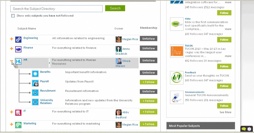TIBCO launches tibbr: enough to make Enterprise 2.0 viable?


I first saw an early iteration of tibbr last year when it was used as a socially mediated communications tool at the company's annual user conference. At the time I thought: 'meh.' It was like another Yammer with little to commend it beyond the ability to discover other attendees, share questions and the like.
Fast forward to last week when I was given a sneak preview of the latest iteration. Today, tibbr is a whole new animal with the ability to do what I have been asking of Enterprise 2.0 technologies. It intelligently marries people, process and context, delivering information the way people want to consume. What do I mean?
You have to step back a bit in order to understand the context. TIBCO has been integrating data and providing process modeling for around 25 years. You'll find TIBCO in large enterprises where there is a need to integrate real time data across disparate applications and systems. It understands massive scale having developed the messaging backbone for NASDAQ and the major Wall Street banks. In 1999, Vivek Ranadivé, TIBCO CEO wrote the book on the publish/subscribe real-time enterprise: The Power Of Now. In other words, TIBCO understands how to move and expose enterprise data at scale in real time.
So what's new, what's to like?
The interface is something that Facebook users will immediately 'get.' It has tabs for events and people but more importantly it includes bi-directional feeds in and out of major applications like Salesforce.com, Oracle Expense Management and SAP CRM. That means business processes can trigger events which are surfaced inside tibbr for action. That might mean working through a sales proposal and ensuring that all the right people are engaged in the process. It could be a service support call where the customer calling in needs information that would otherwise require supervisor escalation. It might mean risk assessment and evaluation in a finance environment where different people need to be engaged at different points along the process workflow. Users can choose to subscribe to the events and people that are of interest to them and do not need to leave the tibbr environment to interact.
I asked Ram Menon, TIBCO's chief marketing officer whether this means that users could use tibbr as an email replacement: "That's possible," he said. If correct then TIBCO is on to something because from what I saw, it is no longer necessary to jump from one application to another. Users can remain within tibbr and still be part of the process flow. That has significant productivity benefit potential because at last what we see is a way to contextually engage in processes with the people who need to be engaged. It doesn't end there.
tibbr can take pretty much any feed including Facebook, Twitter, LinkedIn and RSS. People can opt for certain communications to remain private while others are public. tibbr uses LDAP - which will put a smile on IT's face - and can be delivered as a virtual software appliance rather than as a hosted solution running over the public Internet. tibbr can be audited and archived and take advantage of TIBCO's policy management tools. That should remove many of the management doubts that IT typically has about this type of application.
"We're leveraging a billion dollars of integration technology investment to offer customers the ability to get at the information they need, in real time, if they choose," said Mr Menon.
Will large companies 'get it?' I think they will, or rather their employees will. Users do not need IT support in order to get going with tibbr. From what I saw, the Facebook style interface should be familiar and easy to understand although like Facebook I wonder if it will become a tad messy. The fact I can switch between people and event views simply by clicking a tab means I can manage my event stream in the way that works best for me at the time I need to get something done.
Is there enough of a 'what's in it for me?' factor to ensure adoption? That's harder to discern. In the hour TIBCO spent with me, I felt myself being drawn into what tibbr can offer and seeing use cases without having to worry whether the technology can deliver. Unlike other systems, I wasn't left thinking that this is a solution looking for a problem. It has much more of a self evident feel than other systems I have seen.
If tibbr does serve as an email replacement then TIBCO will need to show IT that it really does do what it says on the tin. IT has significant investments in email management and it may not be as easy for those people to accept tibbr. The CIO argument is easier to parse: direct IT management savings in both hardware and software that can be released to innovation. There are more plus points for IT and the CIO: tibbr is application, system and device agnostic. It can easily slip into any 'typical' large enterprise landscape without requiring system changes.
TIBCO says it will sell into very large companies. "I am looking for the 100,000 and up deployment. We can do those in about two hours. Four weeks into a quiet launch and we have 41,000 active users," says Mr Menon. That's impressive. What will be even more impressive is if tibbr can encourage a change in the way people work that delivers value back to both those who use it and the companies that deploy. In that regard TIBCO will need to do a lot of work beyond its usual way of selling software, providing integration services and then walking away.
More later from the launch event.